Email: [email protected] Ligue agora! +55-11-3717-5537

The base blade is a half-height full width blade that will support up to two MXM style (Mobile PCI Express Module typically for laptops) graphics cards on the blade mezzanine slots. With a Multi-GPU Carrier card the single-width blade will support up to six MXM GPUs. When outfitted with the Graphics Expansion blade, the server is double-width and supports full-size high-end graphics cards. The HPE ProLiant WS460c Gen9 Graphics Server Blade is designed to support applications in computer-aided design (CAD), financial analysis, web design, and digital content creation. This server-based workstation solution provides a more secure environment that’s easier to manage and can be virtualized to support multiple remote users with virtual desktop infrastructure (VDI). This HPE WS460c Gen9 server blade is supported on the c7000 and c3000 enclosures that feature shared interconnect modules, power supplies, fans, and redundant Onboard Administrator modules. Resources can be accessed remotely using a thin client, workstation, PC, and other mobile devices.
The Intel C610 chipset supports either one or two of Intel’s Xeon E5-2600 v3 or E5-2600 v4 processors with up to 22 cores. However, use of the graphics options are only supported in a two-processor configuration.
The system supports up to 1TB using 16 x 64GB Load Reduced (LRDIMM) modules or up to 512GB using 16 x 32GB Registered (RDIMM) memory modules. The top memory speeds for the v4 processors is 2400MHz while the v3 processors support a maximum of 2133MHz depending on quantity and type of DIMMs installed. Only DDR4 memory modules can be used on the system and DDR3 memory modules are not supported. To achieve the best performance HPE recommends using only HPE SmartMemory.
Two small form factor (SFF) drives can be installed up front and all drive bays are hot-plug for easy replacement. Choose from SAS, SATA HDDs or SSDs, or NVMe SSDs. There are three HD/RAID controllers to choose from. The hypervisor can be supported on an internal SD card module.

To ensure a seamless workstation experience network communications include either one dual-port 20GB FlexFabric FLB, a 10GB dual port HPE FlexFabric FLB, a 10GB dual port Ethernet FLB. There are two expansion slots available in the single-width version depending on your choice of mezzanine cards. Expansion slot 1 is unavailable with the double-width model but the double-wide chassis will support a full size card. Additional Mezzanine card options include support for Nvidia and AMD GPUs, plus a dual port 16GB Fibre Channel HBA FPR SAN connectivity, QDR and FDR InfiniBand options, and dual port 20Gb and 10Gb Ethernet. With the single-wide from factor you can choose from several MXM form factor GPUs from Nvidia or AMD. With the Double-width form factor, users can choose from full-sized graphics cards offered by Nvidia and AMD, or using an HPE Multi-GPU Carrier it can support up to four Tesla M6 cards providing the best GPU user density. Virtualized GPU solutions from Nvidia and AMD allow administrators to assign one to sixteen users per physical GPU depending on workload and particular card.
On system management is provided by HPE integrated Lights Out (iLO 2.0) with 4GB NAND and a 1GB USB user space configurable. With the workstation housed in the data center it’s also easier for Administrators to keep secure and manage the system using HPE OneView. Operational costs are further reduced with a shared infrastructure like that offered by the BladeSystem c7000 and c3000 enclosures. With the blade housed in the data center exposure of business critical information and theft of local storage devices is significantly reduced. Multiple layers of redundancy are also built into the enclosure ensuring continuous uptime for users.
The HPE ProLiant WS460c Gen9 Graphics Server is an excellent way to provide a dedicated workstation experience for one or multiple users. Fast network connection speeds and low latency drives, along with partner protocols from Citrix, VMware, and Microsoft help deliver an uncompromising user experience. Both compute and graphics processors can be virtualized to with up to 16 users per GPU.
Maximum (LRDIMM):
Maximum (RDIMM):
Standard iLO Network Controller:
Mezzanine card options include:
| Hot Plug SFF SAS | 4.0TB | 2 x 2.0TB |
| Hot Plug SFF SATA | 4.0TB | 2 x 2.0TB |
| Hot Plug SFF SAS SSD | 7.68TB | 2 x 3.84TB |
| Hot Plug SFF SATA SSD | 7.68TB | 2 x 3.84GB |
| Hot Plug SFF NVMe SSD | 4.0TB | 2 x 2.0TB |
USB 3.0 Port:
Server Operating Systems:
Server blades, interconnect modules, power supplies, fans, and redundant Onboard Administrator modules are all designed to fit into the c3000 and c7000 enclosures.